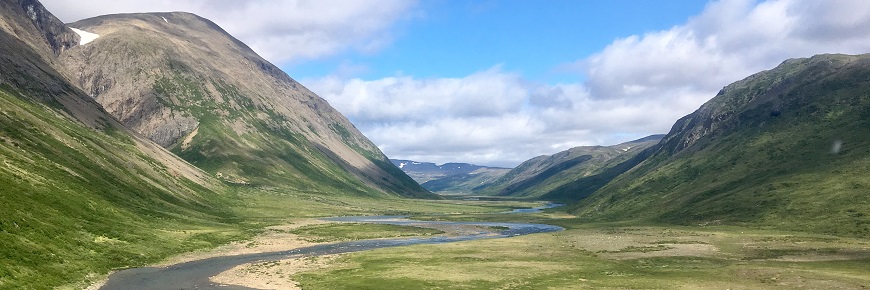
Nakvak Brook Trek
Torngat Mountains National Park
What Do I Need to Know to Hike the Nakvak Brook Trek?
Visitor Registration
Hiking parties who are interested in tackling this hiking route will need to register (before their visit) with Torngat Mountains National Park (Parks Canada) as well as Parc national Kuururjuaq (Nunavik Parks) since the route passes through both parks. Visitors are also required to de-register after they have departed from either of these parks to ensure that staff know they have left the parks and have been accounted for.
Contact Information
Torngat Mountains National Park
Phone: 1-888-922-1290
Email: torngats.info@pc.gc.ca
Parc national Kuururjuaq
Phone: 1-819-337-5454
Email: info@nunavikparks.ca
Website: nunavikparks.ca
Torngat Mountains Base Camp and Research Station
This camp is situated in St. John’s Harbour in Saglek Bay. It presently operates from mid-July until early September. The base camp can provide support for visitor parties wanting to travel into Torngat Mountains National Park. Bear guards, Inuit guides, a helicopter, speed boats and longliners (fishing boats) are generally available for local charter. Please contact the Nunatsiavut Group of Companies by phone (1-855-TORNGAT (867-6428) ext. 26) or email (basecamp@ngc-ng.ca) for inquiries about base camp.

First major waterfall along Nakvak Brook.
© Parks Canada
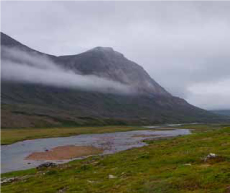
North side of Nakvak Brook at start of section 2 (Day 3).
© Parks Canada
Route Summary
Nakvak Brook Trek
Type of hike: Moderate multi-day hike
Distance: Approximately 68 km / 42 miles
Time required: Allow 5 to 6 days
Elevation gain: 335 metres (1000 feet)
Point of departure:* The mouth of Nakvak Brook in Saglek
Fiord (Pitukkuk) (20 V 482855 E 6484218 N)
Route access:
1. By boat from Nain (N.L.) (approximately 3 days)
2. By boat from base camp (3 hours)
3. By helicopter from base camp (15 minutes)
4. By helicopter from Nain (N.L.) or Kuujjuaq (Que.)(approximately 1.5 hours)
*Note that hiking parties could also be dropped off by helicopter in the
Mount Haywood area (located in Parc national
Kuururjuaq in Québec)
and hike the entire route in the opposite direction to the mouth of Nakvak
Brook in Saglek Fiord.
Route Overview
This spectacular but challenging multi-day hike begins at the mouth of Nakvak Brook (Pitukkik) and ascends the river to its headwaters adjacent to the Québec/Nunavik border. Numerous variations of the hike are possible, including side trips that provide access to scenic side valleys or alpine traverses. This route description will focus on the main route up Nakvak Brook from its mouth in Saglek Fiord. All distances are “straight line” distances; actual travel distances will vary depending on your exact travel route. Nakvak Brook is a traditional route that has linked Inuit from Nunavik (northern Québec) and Nunatsiavut (northern Labrador) for generations—first by foot or by dog team and now, in modern times, by snowmobile.
You can start this hike either by being dropped off by speed boat or longliner, or flown in by helicopter to the mouth of Nakvak Brook and then ascend up either side of the river valley. Alternatively you can fly into the headwaters of Nakvak Brook by helicopter and hike down to Saglek Fiord. Note that you will need to register with Nunavik Parks if you plan on landing an aircraft in Parc national Kuururjuaq.
If you choose the first option (head up Nakvak Brook, which is a large river), remember that you will likely not be able to cross the river until you are two or three days into your hike due to the size (depth and width) of the river. So once you choose your route you will be committed to it for a while. You will quickly discover that caribou trails thread their way upstream through thickets of alder, shrub birch and willow, and easily define walking trails over more open ground. The caribou trails are tricky to follow as they often appear to end abruptly, leaving you to force your way through thick shrubs. However, if you look carefully, often you will find that the trail has just turned right or left and can still be followed.
This hiking route description is based on information collected by Parks Canada and Nunavik Parks in July 2010. The entire description follows the east/north side of Nakvak Brook and is divided into three sections. All visitors are strongly encouraged to consult the “General Hiking Information for Torngat Mountains National Park” document (available here) before planning a hike in the Torngat Mountains.
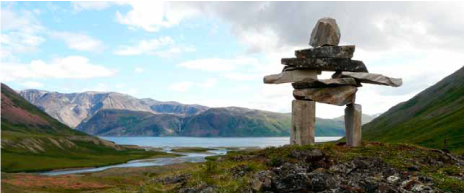
Nakvak Brook inukshuk.
© Parks Canada
Section 1: Mouth of Nakvak Brook (Pitukkik) to River Crossing
20V 482855 E 6484218 N to 20V 468594 E 6500706 N
Approximately 26 kilometres
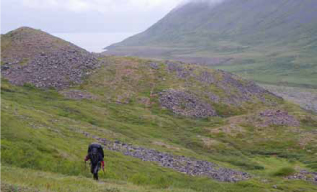
One of several short climbs near the mouth of Nakvak Brook.
© Parks Canada
Route Description
This section takes about two days to complete. It is important to begin your hike as early in the day as possible to give you time to get as far inland from the coast for your first camp site, which will reduce the likelihood of polar bear encounters. Black bears, however, are found throughout the valley and will require you to remain vigilant at all times and manage your campsites and waste appropriately (refer to Managing Waste section of the General Hiking Information for Torngat Mountains National Park document).
The route begins with a series of gravel terraces cut by small intermittent mountain streams. Vegetation is quite sparse on the gravel flats, but can be thick in the deep stream gullies that cut the gravel terrace. You will climb in and out of these gullies for the first couple of hours of your hike and slowly gain the crest of a large old landslide about 2.8 km from the start of the hike. Once you have gained the crest of the ridge you will have a beautiful view up the valley as well as back to Saglek Fiord. If you are on the west side of the river you will see a large inukshuk on a prominentmound. This site is a special place that signifies the connection between Nunavik Inuit and Nunatsiavut Inuit and represents the bond between generations. It is a place that has gained significance for youth and Elders, who recognize the importance of passing on Inuit Knowledge and connecting Inuit youth to their culture and their land. The inukshuk was commemorated in 2009 by the Torngat Mountains National Park Cooperative Management Board. Take time to reflect on the significance of this place. Imagine Elders surrounded by youth, recounting stories of the past, while children laugh and play. Caribou amble by, black bears forage on the slopes and hawks, owls and falcons soar over head. The land is alive and Inuit are an integral part of its rhythms.
Turning north, you can see the valley laid out before you. It is wide and relatively flat. Despite the fact that you are travelling upstream, the slope is barely detectable. For the next day and a half you will travel over a mix of gravel terraces, grassy meadows and a mix of birch, willow and alder thickets. The valley will begin to curve to the west and a series of high lateral moraines and old river terraces begin to dominate the sides of the valley. A spectacular water fall can be seen at 20V 476481 E 6498853 N, which is approximately 17 km into the hike. Take time to wander down and have a closer look at the falls—this could be a good lunch spot for your second day.
Once you leave the falls you will pick your way through low birch scrub and wet grassy meadows until you gain the lateral ridge once again. Follow the ridge until you find yourself above open gravel flats and then drop down to the valley bottom. For the remainder of day 2 you can easily follow the river’s edge. At KM 26 or 27 (20V 468594 E 6500706 N) you will have a challenging river crossing. It is best to plan your crossing in the lower braided sections of the stream where it breaks into 2 or 3 channels. Higher upstream, the brook is fastflowing and steep—too dangerous for crossing.
Remember that the amount of water in the river will vary depending upon the time of year and the amount of recent rainfall. The water is cold and the boulders are big. You would be advised to carry sandals, and if you do not like cold water, bring neoprene booties also. Trekking poles and a rope are also very useful.

Looking east on Day 3 from the north side of Nakvak Brook.
© Parks Canada
Section 2: River Crossing to Nakvak Lake
20V 468594 E 6500706 N to 20V 457471 E 6501073 N
Approximately 14 kilometres

Hikers heading towards flat terrain along the north edge of Nakvak Lake.
© Parks Canada
Route Description
This section is the hardest section of the hike. The description that follows is based on the trip log of Parks Canada and Nunavik Parks staff who hiked the north side of the Nakvak Brook during this part of the hike. However, based on their experience, it may actually be easier and shorter to cross Nakvak Brook (at KM 26 or 27) and follow the south side of the river for this portion of the hike. However, there will be a steep rocky climb to get up to Nakvak Lake at the end of this section if you remain on the south side until you reach the lake. It may also be difficult to cross the river above the waterfall, which is located at the eastern tip of Nakvak Lake.
If you do choose to hike on the south side of Nakvak Brook for this section of the hike, it is recommended that you cross back over to the north side of the brook below the waterfall and ascend the vegetated slopes to a low hill just north of Nakvak Lake. This option allows access to the north side of the lake which is the best shoreline to hike along.
As mentioned in the previous paragraph, this route description follows the south-facing slopes on the north side of Nakvak Brook, which are heavily vegetated with dwarf birch intermixed with alder and willow in the wetter areas around streams.
Pick your way carefully, and look closely for old caribou trails that link bare patches of rock, tundra and meadows. Even though the trails are overgrown, it is still easier to wade through the birch covering the trails than to force your way through the thickets. Patience is the key to this day. Depending upon your tenacity, you could make it to Nakvak Lake for camp 3 (20V 457471 E 6501073 N) in one day.
Caution is required when crossing creeks flowing in from the north (if you choose to hike along the north side of Nakvak Brook for this portion of the hike). Some of these creeks are deeply cut canyons that are dangerous to descend. You will need to find suitable locations either up or downstream for crossing. In early summer, snow bridges may still persist. Take great care when crossing these snow bridges and make sure they are more than thick enough to support you. Cross one person at a time and use a rope if you have one.
Just below the outflow of Nakvak Lake there is a spectacular series of rapids and waterfalls which are well worth the side trip. If you are lucky you may see golden eagle or rough legged hawk nests. Short-eared owls have also been seen here hunting for lemmings in the evening. Short-eared owls are listed as a species at risk and sightings in the park are rare.
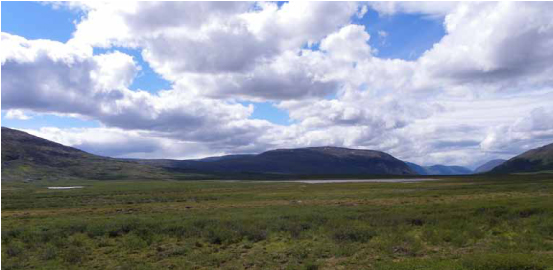
View looking west near the NL/QC border.
© Parks Canada
Section 3: Nakvak Lake to Nunavik Border
20V 468594 E 6500706 N to 20V 457471 E 6501073 N
Approximately 14 kilometres
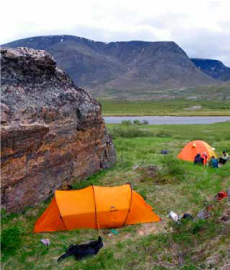
Sheltered campsite in the upper Nakvak Brook valley.
© Parks Canada
Route Description
This section features some of the easiest hiking in the Torngat Mountains. It starts with an enjoyable hike along the north shore of Nakvak Lake. You can either walk along the beach or pop up onto the tundra and follow caribou trails on the bank above the beach. Winds can be quite strong in this section of the hike, so be prepared for strong headwinds and select your campsites carefully. Find a sheltered spot that allows some protection from the wind, as shown in the picture above to the right.
Immediately west of the lake, the river braids into low-lying marsh. This section can be quite wet for the next 4 kilometres. It is best to hike along the side of the valley to avoid the wetter areas—otherwise, be prepared for multiple stream crossings. Beyond the marsh the ground is flat, hard, dry tundra which would be suitable to land a Twin Otter on (20V 446103 E 6499527 N). Hiking is fast and easy over this terrain. To the north, there is a high cliff face. Look carefully; there is a peregrine falcon nest on this cliff. If you are lucky you may see one hunting for small birds or mammals.
The remainder of the hike to the border (approx 15 km) is a mix of hard dry tundra flats, and some braided-stream wetlands, with one more small canyon to cross. Once you reach the border you are in Nunavik/Québec—where there is a one hour time difference (one hour earlier)—and Parc national Kuururjuaq. If you plan to continue your hike beyond this point, you must register with Nunavik Parks beforehand (1-819-964-2961 extension 2411).
Important UTM Coordinates
Landing sites for Twin Otter in the area:
Suggested campsites:
The following are suggested campsites based on expected travel distances for each day starting at the mouth of Nakvak Brook.
Points of interest:
- Date modified :
